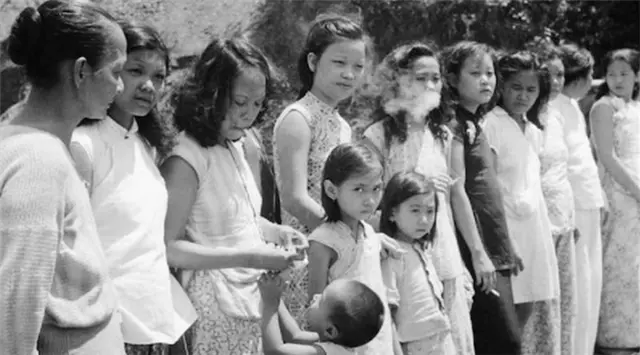Almost a month has passed since the release of Spirits' Homecoming, a film portraying Japan's sexual brutality toward Korean girls during World War Two, but lots of South Koreans still went to see the period drama movie on Sunday.
Despite the overwhelming Hollywood blockbusters occupying screens, the film has stood as one of box office hits in South Korea since it was released on Feb. 24.
According to the Korean Film Council's electronic tally, ticket sales have topped 3.3 million as of Friday.
At a multiplex theater in Seoul, many fathers and mothers came with their children to let the youngsters know about the truth of their country's painful history.
In the past month, lots of viewers came in groups from different segments such as teachers and students, politicians and various organizations.
Local newspaper Hankyoreh called the "group watching" as a social phenomenon.
An online ticket-buying campaign was organized before its premiere to help it secure sufficient screens.
About 75,200 people donated money or participated in an online crowdfunding to help finance the movie.
South Korean netizens said in online postings that watching the movie is not about just watching a movie, but about remembering the heartrending stories of former sex slaves, called comfort women, that become their own history under the Japanese colonial rule.
Director Cho Jung-Rae tried to console the "spirits of little girls" who were killed in strange lands and help cure the pain of surviving victims by allowing two girls in the movie, who were dragged off to Japanese military brothels together and among whom only one survived, to have a spiritual meeting scores of years later by the help of a shaman.
The movie starts with a scene that depicts a serene rural area set in 1943 on the Korean Peninsula.
A man walks along ridges between rice paddies, singing a folk song. When he meets his 14-year-old daughter, he starts to laugh happily, calling her a "little puppy."
He puts his smiling daughter on a Korean traditional A-frame carrier on his back.
The peaceful life of a family abruptly turns into a tragedy after Japanese soldiers forcibly take away the 14-year-old without any explanations.
Jung-Min, played by ethnic Korean-Japanese Kang Ha-Na whose mother also plays a Japanese pimp in the movie, is hauled into a train where many other Korean teenage girls are being transported to unknown places.
The lives of Jung-Min and other young girls become a nightmare after arriving at a Japanese army unit.
They were thrown into "comfort stations" where Japanese soldiers are allowed to discharge their sexual desire.
The rooms turn into a hell, with some girls brutally dragged and raped and others beaten and hurled.
The brutality is repeated again and again by hundreds of soldiers lining up in front the rooms.
It is something that young girls can never endure, and the nightmare continues in the lives of survivors to this day.
The indelible pain is portrayed by older Young-Hee who served in the comfort station along with Jung-Min when she was 16 years old but solely survived a massacre by Japanese soldiers running away.
The character of Young-Hee is based loosely on Kang Il-Chul, one of surviving victims of Japan's wartime sexual slavery.
Among the 238 known South Korean former sex slaves, only 44 are alive as two passed away this year.
South Korean historians say hundreds of thousands of women, mostly from the Korean Peninsula, forcibly served in Japanese military brothels during WWII.
Kang's painting, titled Burning Virgins, reportedly inspired director Cho to decide on producing the film. It was drawn during her psychotherapy in 2002 to portray a group of young girls being burned alive in a large pit and another group on a truck being transported by Japanese soldiers to the pit.
The painting contains a real story Kang experienced when she was forcibly taken away as a sex slave to a Japanese army unit in Changchun, Jilin province of China, in 1943. At the time, she was just 16 years old.
Japanese soldiers took girls who were suffering from disease to an incinerator.
The girls were shot and burned to death as Japan sought to destruct evidence on what its Imperial Army had done to young girls.
Kang miraculously survived as troops of the Korean independence army attacked Japanese soldiers at that time.
It took about 14 years to make the horrible story into a film since Cho first saw the painting in 2002 at the House of Sharing, a nursing home for the elderly comfort women victims including Kang.
Cho had difficulty in finding investors, allowing the indie film director to begin shooting the film only in April 2015.
Tens of thousands of ordinary people participated in an online crowdfunding and voluntary donation, while many actors worked without pay.
One member of the production team even mortgaged his house to make a financial contribution.
The indie film director also found difficulty in securing sufficient screens in consideration of close ties between major South Korean theater chains and Japan.
Online campaigns spread to buy tickets in advance and sign petitions for increased screens in major film distributors.
Above all, the "comfort women" had long been a taboo topic to bring up in a sexually conservative South Korean society.
The first public testimony on the atrocious sex enslavement was made here decades of years after Japan's surrender in the devastating war in 1945.
The late Kim Hak-Sun first came forward to testify as one of Japan's wartime sexual slavery victims on Aug. 14, 1991.
Since then, a rally has been held every Wednesday in front of the Japanese embassy in Seoul by surviving victims, but Prime Minister Shinzo Abe has denied the forced recruitment of young girls and the involvement of the Japanese government and military.
 简体中文
简体中文

